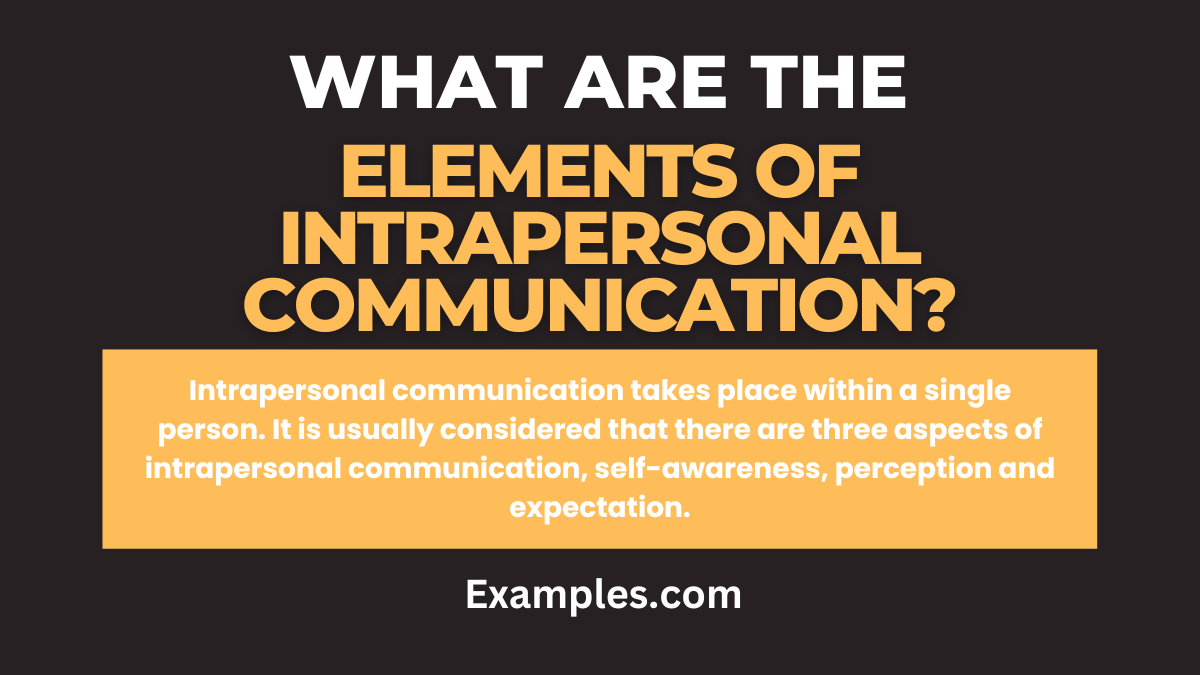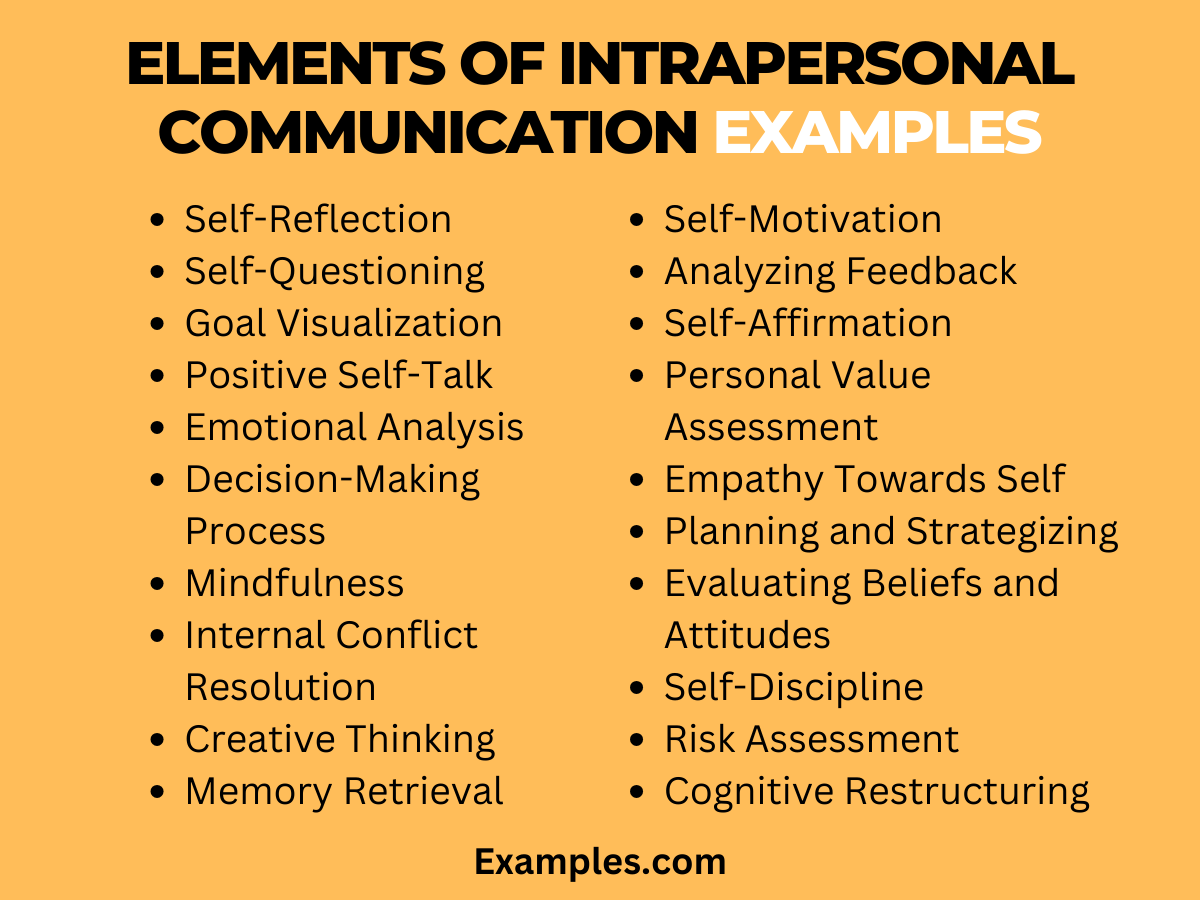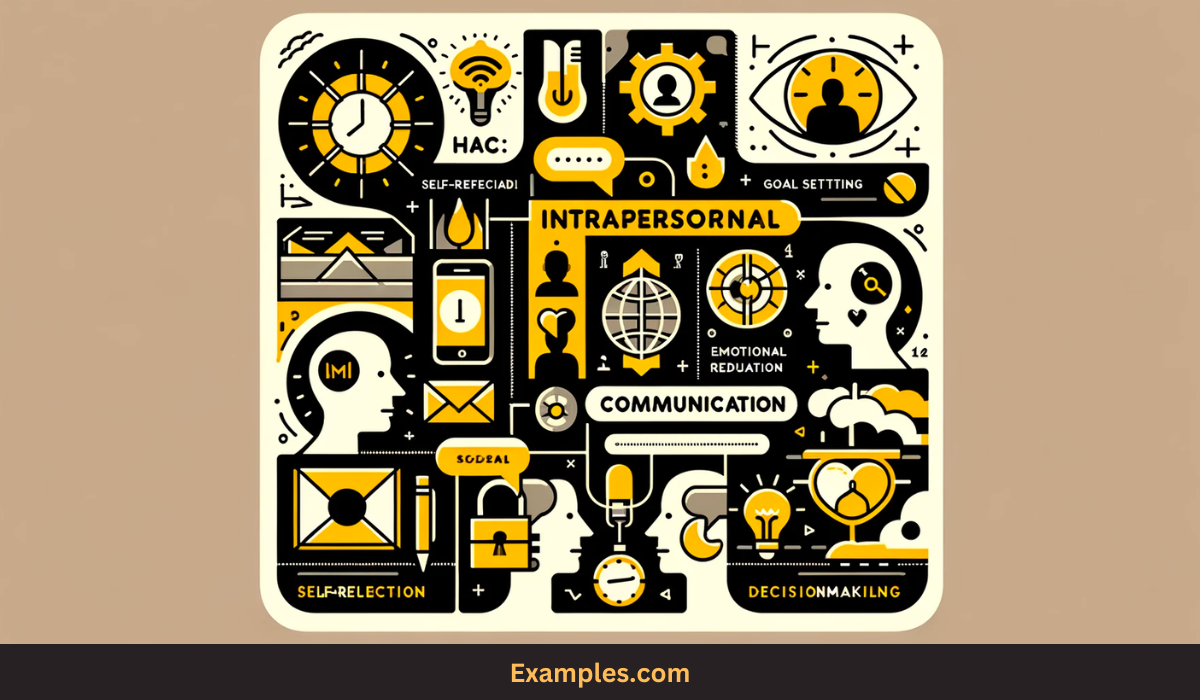19+ Elements of Intrapersonal Communication Examples
In the realm of personal development, understanding the Elements of Intrapersonal Communication is key to mastering self-dialogue. This comprehensive guide delves into the intricacies of communicating with oneself, highlighting various components that make it effective. Peppered with practical Intrapersonal Communication Examples, this resource is designed to offer insights into how to engage in productive internal conversations. Whether for emotional regulation, decision-making, or self-reflection, this guide provides the tools needed for enhancing your intrapersonal communication skills.
What are the Elements of Intrapersonal Communication?

Intrapersonal communication is the process of internal dialogue within oneself, encompassing thoughts, feelings, and self-talk. This essential aspect of Intrapersonal Communication Skills plays a crucial role in self-awareness and emotional intelligence. The core elements include self-perception, internal language, and emotional understanding. These components are integral to reflective thinking and effective Intrapersonal Communication Examples. They enable individuals to process information, analyze experiences, and make thoughtful decisions, thereby enhancing personal growth and emotional well-being.
20 Elements of Intrapersonal Communication Examples

Intrapersonal communication, the dialogue we have with ourselves, is integral to our personal development and emotional well-being. This guide highlights 20 elements that form the foundation of effective intrapersonal communication, each accompanied by an example. These elements are essential in shaping how we think, feel, and react to various situations, thereby enhancing our self-awareness and decision-making capabilities.
- Self-Reflection: This involves a deep and honest look at one’s thoughts, beliefs, and feelings. It’s about understanding your motivations, desires, and reactions to different life events. Self-reflection is key to personal growth and self-awareness.
Example: “In my quiet moments, I reflect on my day’s actions and consider how they align with my values.” - Self-Questioning: This is the practice of asking oneself important, sometimes challenging, questions. It’s a way to gain deeper insights into one’s own feelings, decisions, and behaviors.
Example: “I often ask myself, ‘What truly makes me happy?’ to ensure I’m on the right path.” - Goal Visualization: This involves picturing oneself achieving future goals and successes. It serves as a powerful motivational tool and helps set clear directions for one’s aspirations.
Example: “I visualize myself leading a successful team, which motivates me to develop my leadership skills.” - Positive Self-Talk: Encouraging and motivating oneself through affirming and positive statements. It’s crucial for building self-esteem and overcoming negative thoughts.
Example: “When facing a challenge, I remind myself, ‘I have overcome difficulties before, I can do it again’.” - Emotional Analysis: Understanding and acknowledging one’s own emotions. This process involves recognizing how and why certain feelings emerge, which is essential for emotional regulation.
Example: “I acknowledge my frustration with this task and explore ways to approach it calmly.” - Decision-Making Process: Involves contemplating various options and their potential outcomes. It’s about making informed and thoughtful choices.
Example: “When deciding on a career move, I consider both the short-term and long-term impacts on my life.” - Mindfulness: Being fully present and aware of one’s current thoughts and feelings without judgment. This practice enhances focus and helps in managing stress.
Example: “During stressful times, I practice mindfulness to remain calm and centered.” - Internal Conflict Resolution: The process of addressing and resolving inner disputes and dilemmas. It’s essential for maintaining emotional balance and clarity.
Example: “I resolve my internal conflict between work and family by setting clear boundaries for both.” - Creative Thinking: Generating innovative ideas and perspectives internally. This element fosters problem-solving skills and creative expression.
Example: “In brainstorming sessions, I encourage myself to think outside the box for unique solutions.” - Memory Retrieval: Recalling past experiences and lessons learned. This helps in making better decisions based on previous knowledge.
Example: “Remembering how I successfully handled a past conflict guides my approach to current challenges.” - Self-Motivation: Pushing oneself to take action and continue striving towards goals. It’s a key factor in achieving personal and professional objectives.
Example: “I motivate myself to finish this project by remembering the satisfaction of completing challenging tasks.” - Analyzing Feedback: Reflecting on feedback from others to understand its relevance and use it for personal growth. Example: “I consider my mentor’s advice carefully to identify areas where I can improve.”
- Self-Affirmation: Positively reinforcing one’s own strengths, abilities, and accomplishments. This boosts confidence and self-worth.
Example: “I affirm my skills and achievements regularly to build my self-esteem.” - Personal Value Assessment: Identifying what is most important to oneself. This guides decision-making and behavior.
Example: “I regularly assess my values to ensure my actions align with them, like prioritizing family time.” - Empathy Towards Self: Offering oneself understanding and compassion, especially during challenging times.
Example: “When I make a mistake, I remind myself that it’s a learning opportunity, not a failure.” - Planning and Strategizing: Developing detailed plans for achieving goals. Effective planning is crucial for success and productivity.
Example: “I create a step-by-step plan for my career goals, breaking them down into manageable tasks.” - Evaluating Beliefs and Attitudes: Continuously reassessing one’s own beliefs and attitudes to ensure they align with current goals and values.
Example: “I regularly question my beliefs to ensure they are not limiting my potential.” - Self-Discipline: Exercising control over one’s actions and impulses. It’s vital for consistency in pursuing long-term goals.
Example: “I practice self-discipline by maintaining a regular exercise routine, even when I don’t feel like it.” - Risk Assessment: Evaluating potential risks in decision-making processes. This helps in making informed choices and avoiding pitfalls.
Example: “Before any major decision, I weigh the risks against the potential benefits.” - Cognitive Restructuring: Changing negative thought patterns into more positive, constructive ones. This is crucial for maintaining a healthy mindset.
Example: “Whenever I catch myself doubting my abilities, I replace those thoughts with reminders of my past successes.”
These elements of intrapersonal communication are crucial in building a strong foundation for personal growth, emotional intelligence, and effective decision-making. By understanding and applying these elements, one can navigate life’s challenges with greater clarity and confidence.
Basic Elements of Intrapersonal Communication

The Basic Elements of Intrapersonal Communication play a critical role in how we understand ourselves and navigate our internal world. This comprehensive guide, optimized for “Elements of Intrapersonal Communication,” delves into the foundational aspects that constitute effective self-communication. By mastering these elements, one can significantly enhance their self-awareness, emotional regulation, and decision-making abilities, which are crucial for personal growth and well-being.
Thought Recognition

The first step in intrapersonal communication is recognizing and understanding your thoughts. This involves being aware of the continuous stream of ideas, beliefs, and perceptions that run through your mind. Thought recognition helps in identifying patterns in thinking that may influence your behavior and emotional responses. For instance, realizing that a thought like “I can tackle this challenge” can shift your mindset from anxiety to confidence.
Feeling Identification

Being able to identify and name one’s emotions is a cornerstone of emotional intelligence. This skill allows you to understand and manage your feelings effectively. It involves acknowledging emotions, whether positive or negative, and understanding their impact on your thoughts and actions. For example, recognizing a feeling of excitement about a new project can help channel that energy into productive action.
Internal Monologue
Your internal monologue is the ongoing conversation you have with yourself, which influences how you interpret and react to situations. It shapes your understanding of the world and plays a vital role in your decision-making process. A positive and constructive internal monologue can boost self-esteem and motivation, whereas a negative one can lead to self-doubt and anxiety.
Self-Perception
How you view yourself, including your beliefs about your abilities and traits, significantly impacts your intrapersonal communication. A healthy self-perception involves recognizing your strengths and acknowledging areas for improvement. It influences your confidence, motivation, and overall mental well-being. Understanding your self-perception helps in aligning your actions with your true self.
Introspection
Introspection is the process of looking inward to explore your feelings, motivations, and desires. It’s a critical aspect of self-understanding and personal development. Through introspection, you can gain insights into why you react to certain situations in specific ways and how your experiences shape your beliefs and attitudes.
Self-Dialogue

The conversations you have with yourself, or self-dialogue, play a significant role in shaping your thoughts and behaviors. This internal dialogue can be a powerful tool for self-encouragement, problem-solving, and reflection. Constructive self-dialogue can lead to better emotional management and decision-making.
Imagination
Imagination in intrapersonal communication involves creating scenarios, ideas, or images in your mind. It’s a crucial element for creative thinking and problem-solving. Using your imagination, you can visualize successful outcomes, explore different perspectives, and come up with innovative solutions to challenges.
Memory Processing
Memory processing involves recalling and interpreting past experiences. This element is vital for learning from past actions and planning for the future. Reflecting on past experiences, both successes and failures, can provide valuable lessons and inform your future decisions.
Value Clarification
Understanding and defining your core values is essential for guiding your behavior and decisions. Values clarification helps you to make choices that are in alignment with your beliefs and principles. It ensures that your actions and goals are congruent with what truly matters to you.
Self-Evaluation

Regular self-evaluation is key for personal development and improvement. It involves assessing your abilities, actions, and performance. Through self-evaluation, you can identify areas of strength and areas that require development, setting the stage for continuous growth and learning.
In conclusion, these basic elements of intrapersonal communication are integral to developing a deeper understanding of oneself. By focusing on and refining these elements, you can improve your internal dialogue, leading to a more fulfilled and self-aware life.
In summary, this guide on the Elements of Intrapersonal Communication provides invaluable insights into the fundamentals of internal dialogue. Understanding these elements is crucial for enhancing self-awareness, emotional intelligence, and decision-making. Armed with these tips and examples, individuals can significantly improve their intrapersonal communication skills, leading to more effective personal growth and a deeper understanding of oneself.



